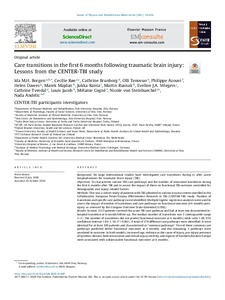Care transitions in the first 6 months following traumatic brain injury: Lessons from the CENTER-TBI study
Borgen IMH; Tenovuo O; Eveline JAW; Jacob L; Cogné M; ; Ranta J; Majdan M; Tverdal C; Andelic N; Røe C; Dawes H; Rusnak M; Steinbuechel NV; Azouvi P; Brunborg C
Care transitions in the first 6 months following traumatic brain injury: Lessons from the CENTER-TBI study
Borgen IMH
Tenovuo O
Eveline JAW
Jacob L
Cogné M
Ranta J
Majdan M
Tverdal C
Andelic N
Røe C
Dawes H
Rusnak M
Steinbuechel NV
Azouvi P
Brunborg C
Julkaisun pysyvä osoite on:
https://urn.fi/URN:NBN:fi-fe2022021519253
https://urn.fi/URN:NBN:fi-fe2022021519253
Tiivistelmä
Background: No large international studies have investigated care transitions during or after acute hospitalisations for traumatic brain injury (TBI).
Objectives: To characterise various TBI-care pathways and the number of associated transitions during the first 6 months after TBI and to assess the impact of these on functional TBI outcome controlled for demographic and injury-related factors.
Methods: This was a cohort study of patients with TBI admitted to various trauma centres enrolled in the Collaborative European NeuroTrauma Effectiveness Research in TBI (CENTER-TBI) study. Number of transitions and specific care pathways were identified. Multiple logistic regression analyses were used to assess the impact of number of transitions and care pathways on functional outcome at 6 months post-injury as assessed by the Glasgow Outcome Scale-Extended (GOSE).
Results: In total, 3133 patients survived the acute TBI-care pathway and had at least one documented in-hospital transition at 6-month follow-up. The median number of transitions was 3 (interquartile range 2-3). The number of transitions did not predict functional outcome at 6 months (odds ratio 1.08, 95% confidence interval 1.09-1.18; p = 0.063). A total of 378 different care pathways were identified; 8 were identical for at least 100 patients and characterized as "common pathways". Five of these common care pathways predicted better functional outcomes at 6 months, and the remaining 3 pathways were unrelated to outcome. In both models, increased age, violence as the cause of injury, pre-injury presence of systemic disease, both intracranial and overall injury severity, and regions of Southern/Eastern Europe were associated with unfavourable functional outcomes at 6 months.
Conclusions: A high number of different and complex care pathways was found for patients with TBI, particularly those with severe injuries. This high number and variety of care pathway possibilities indicates a need for standardisation and development of "common data elements for TBI care pathways" for future studies.
Study registration: ClinicalTrials.gov NCT02210221.
Kokoelmat
- Rinnakkaistallenteet [19207]
